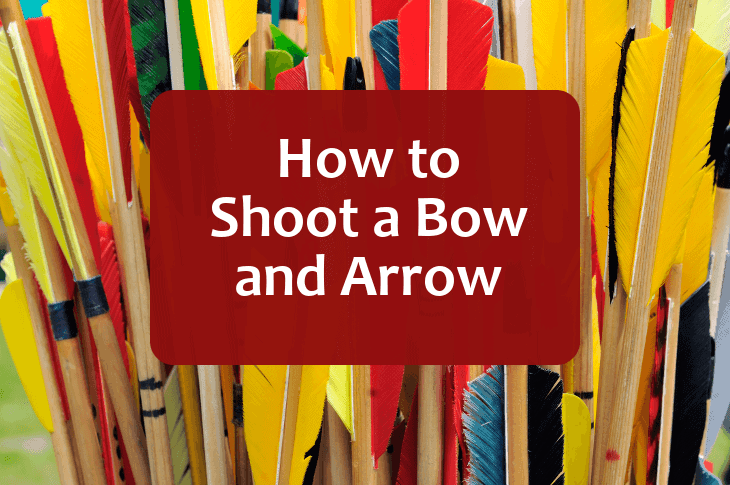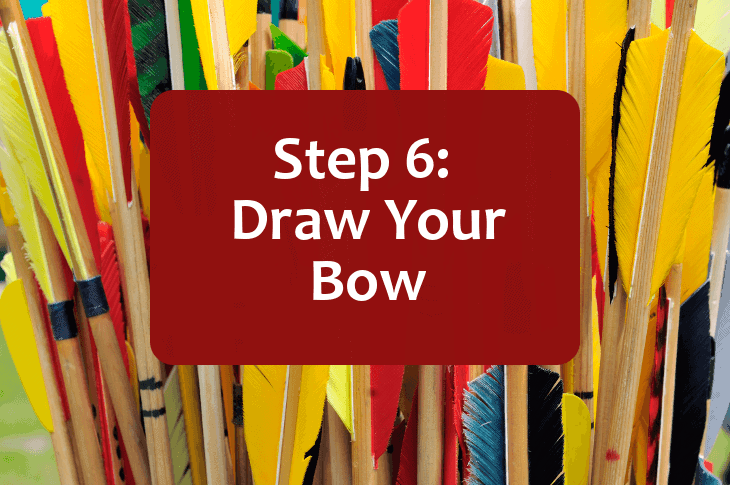Welcome to the Complete Guide to Archery! I’ve created this post as an overview of the shot sequence. I introduce each step, and if you want to learn more about each step, click on the link and you’ll find detailed instructions about how to complete it.
These are a general guideline of the archery shot sequence; they’re not written in stone, and they’re simply meant to be an outline of how to shoot a bow and arrow. You’ll likely need to add steps, or alter steps, as you learn more about the sport and become a better archer.
Go through each of the posts, and try to incorporate the steps in your archery shot. And—this is most important—don’t rely solely on this site! Talk to experienced archers at your range, talk to club members and staffers, read read read as much you can on archery forums, and if you’re really serious about things, look into getting a coach.
In other words—find as many sources as possible, and learn from all of them. Archery—perhaps more than other sports—is a “community of knowledge” sport. We’re all learning, and the vast majority of us LOVE talking about archery. We want to talk and share knowledge. Talk to the folks you meet, because it’s a rare instance where you talk to archer and she/he doesn’t want to talk your ear off about archery.

The Steps Below…
…are for beginner archers using a recurve bow or a compound bow (and traditional bows, too). Many parts of the draw process are the same for all types of bows, and I’ll point out areas where they are different. On occasion, I’ll point out some advanced ideas, just to build your knowledge.
To me, the most amazing thing about archery is that within a single session, you’ll have gotten the hang of it. You’ll have learned the basic steps necessary to connect your arrows to the target. You’ll understand the major concepts, and you’ll have hit the target a number of times—and maybe even hit a couple of bulls eyes.
It will take a lot longer than that to master the art of archery—but within a one or two lessons, you’ll be impressing yourself and having fun. That’s amazing to me—that people of all ability levels are able to get the “knack” so quickly.
Enough Already, Show Me the Steps
Here they are, along with an important “pre-step” that every archer needs to think about.
Pre-Step to Step 1: Determine Your Dominant Eye. In the same way you have a dominant hand—some people are left-handed, and some people are right-handed—you have a dominant eye, and it’s very important to how you aim. We’ll go over how to figure out if you’re “left-eyed” or “right-eyed,” what it means to your shot, and what to do if you’re “cross dominant.”
Step 1: Get Your Stance Correct. This is one of the most overlooked aspects of archery, and I’ll help you determine the best stance for you. I’ll go over each body part and help you get oriented so that you can repeat perfect posture, every time you shoot.
Step 2: Nock Your Arrow. This one seems like a no-brainer, but there are some things you’ll want to keep in mind. We’ll go over nock locators, nocking points, and a couple of safety tips.
Step 3: Grasp Your Bow String. There are a couple of different ways to grasp your bow string, and we’ll go over the most popular method. We’ll also go over gear that protects your hands and fingers, because shooting without protective gear can be VERY painful, and it can even cause some long-term damage to your hands.
Step 4: Ready Your Bow Hand. Many new archers use a death grip, when the fact is that a relaxed, calm grip will do just fine. I have a few photos of what a relaxed grip looks like, and discuss a couple of grips you want to avoid.
Step 5: Ready Your Bow Arm. Archery is a LOT about alignment, and we’ll talk about the 9-and-3 rule, how to make sure your shoulders are relaxed, and how to steady your arm.
Step 6: Draw the Bow. We’ll go through a quick checklist of things you want to keep in mind when you pull the bow string back towards you. This is the first time during the sequence where you’ll actually be using your muscles, so it’s particularly important.
Step 7: Find Your Anchor Point. Here, we’ll define an anchor point, determine how to use your anchor point on a recurve bow vs. a compound bow, and discuss some of the finer points about the draw.
Step 8: AIM. The most important—and somehow least important!—step of the whole process. We’ll talk bow sights, instinctive shooting, and aiming on a recurve vs. aiming on a compound.
Step 9: Release Your Arrow. Time to let go! We’ll go over dynamic release, how your muscles should feel when you release an arrow, and some things you want to avoid when you’re letting your arrow fly.
Step 10: Follow-Through and Analysis. This step is my personal favorite—reviewing your shot, and figuring out what went right and what went wrong. I get a little deep, and talk about meditation.
That’s a Lot of Steps
You may be thinking, “Why on earth do you need all these steps? I’ve seen archers, and they shoot arrows quickly and smoothly. They don’t seem to be following steps.” And, you’re right—ten entire steps does kind of seem like a lot. The thing is, following the steps is really, really easy. Surprisingly easy. (It’s mastering them that’s hard!).
Most of these steps are things you would normally do when you’re shooting a bow and arrow—you look at your feet, you nock an arrow, etc. These are things that would feel weird if you *didn’t* do. So don’t worry about being overwhelmed with the number of steps in the sequence—you’ll be amazed at how quickly you pick them up.
Repetition is the Heart of Archery
And, I’m realizing now, “The Heart of Archery” is a fantastic name, and that’s what I should have named this website.
Just a heads up: I repeat some information in different posts, but I do that because 1) repetition is helpful when you’re learning something new, and 2) I’m forgetful.
Feel free to read and re-read them, and if you’ve got questions, ask away in the “Comments” section. I’ll reply and share what I know, and I hope other archers will share what they know, too.
If You’re a Hunter
These steps are mainly for archers at a range, shooting at a stationary target. Archers on a hunt may be shooting down from an elevated position, or at a close-range target from an odd angle, so they’ll obviously have different considerations to take into account. That said, hunters can practice the steps below, and adapt them for use on a hunt.
Happy Shooting! And…
…If you have any questions, leave them in the “Comments” section, and I’ll do my best to answer them!
[tcb-script type=”application/ld+json”]{ “@context”: “https://schema.org/”, “@type”: “HowTo”, “name”: “How to Shoot a Bow and Arrow: A Step-by-Step Guide”, “description”: “Welcome to the Complete Guide to Archery! I’ve created this post as an overview of the shot sequence. I introduce each step, and if you want to learn more about each step, click on the link and you’ll find detailed instructions about how to complete it.These are a general guideline of the archery shot sequence; they’re not written in stone, and they’re simply meant to be an outline of how to shoot a bow and arrow. You’ll likely need to add steps, or alter steps, as you learn more about the sport and become a better archer.”, “estimatedCost”: { “@type”: “MonetaryAmount”, “currency”: “”, “value”: “0” }, “step”: [{ “@type”: “HowToStep”, “text”: “Determine Your Dominant Eye. In the same way you have a dominant hand—some people are left-handed, and some people are right-handed—you have a dominant eye, and it’s very important to how you aim. We’ll go over how to figure out if you’re left-eyed or right-eyed, what it means to your shot, and what to do if you’re cross dominant.” },{ “@type”: “HowToStep”, “text”: “Get Your Stance Correct. This is one of the most overlooked aspects of archery, and I’ll help you determine the best stance for you. I’ll go over each body part and help you get oriented so that you can repeat perfect posture, every time you shoot.” },{ “@type”: “HowToStep”, “text”: “Nock Your Arrow. This one seems like a no-brainer, but there are some things you’ll want to keep in mind. We’ll go over nock locators, nocking points, and a couple of safety tips.” },{ “@type”: “HowToStep”, “text”: “Grasp Your Bow String. There are a couple of different ways to grasp your bow string, and we’ll go over the most popular method. We’ll also go over gear that protects your hands and fingers, because shooting without protective gear can be VERY painful, and it can even cause some long-term damage to your hands.” },{ “@type”: “HowToStep”, “text”: “Ready Your Bow Hand. Many new archers use a death grip, when the fact is that a relaxed, calm grip will do just fine. I have a few photos of what a relaxed grip looks like, and discuss a couple of grips you want to avoid.” },{ “@type”: “HowToStep”, “text”: “Ready Your Bow Arm. Archery is a LOT about alignment, and we’ll talk about the 9-and-3 rule, how to make sure your shoulders are relaxed, and how to steady your arm.” },{ “@type”: “HowToStep”, “text”: “Draw the Bow. We’ll go through a quick checklist of things you want to keep in mind when you pull the bow string back towards you. This is the first time during the sequence where you’ll actually be using your muscles, so it’s particularly important.” },{ “@type”: “HowToStep”, “text”: “Find Your Anchor Point. Here, we’ll define an anchor point, determine how to use your anchor point on a recurve bow vs. a compound bow, and discuss some of the finer points about the draw.” },{ “@type”: “HowToStep”, “text”: “AIM. The most important—and somehow least important!—step of the whole process. We’ll talk bow sights, instinctive shooting, and aiming on a recurve vs. aiming on a compound.” },{ “@type”: “HowToStep”, “text”: “Release Your Arrow. Time to let go! We’ll go over dynamic release, how your muscles should feel when you release an arrow, and some things you want to avoid when you’re letting your arrow fly.” },{ “@type”: “HowToStep”, “text”: “Follow-Through and Analysis. This step is my personal favorite—reviewing your shot, and figuring out what went right and what went wrong. I get a little deep, and talk about meditation.” }] }[/tcb-script]




